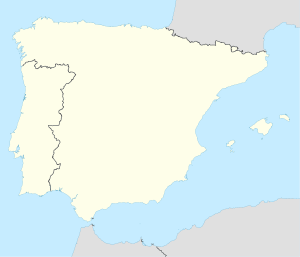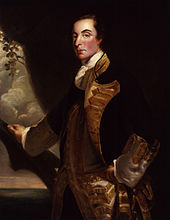- Battle of Cape St. Vincent (1780)
-
Battle of Cape St. Vincent Part of the American War of Independence 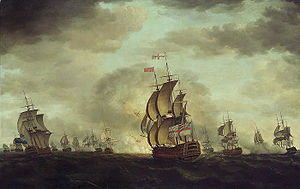
The moonlight Battle off Cape St Vincent, 16 January 1780 by Francis Holman, painted 1780, shows the Santo Domingo exploding, with Rodney's flagship Sandwich in the foreground.Date 16 January 1780 Location Off Cape St. Vincent, Portugal Result British victory Belligerents  Great Britain
Great Britain Spain
SpainCommanders and leaders Sir George Rodney Don Juan de Lángara (POW) Strength 18 ships of the line
6 frigates[1]9 ships of the line
2 frigates[2]Casualties and losses 32 killed
102 wounded[3]1 ship destroyed
4 ships captured[2][3]
2,500 captured, killed or wounded
fate of 2 ships disputed (see Aftermath)[4]European waters
1775–1782- North Channel
- 1st Ushant
- English Channel
- 1st Jersey
- 14 September 1779
- Flamborough Head
- 11 November 1779
- 8 January 1780
- Cape St. Vincent
- Cape Santa Maria
- 2nd Jersey
- Minorca
- 1 May 1781
- 30 May 1781
- Dogger Bank
- 2nd Ushant
- 16 March 1782
- 20 April 1782
- Gibraltar
- Cape Spartel
- 12 December 1782
Anglo-Spanish War1779–1783
English Channel – Gibraltar – Lake Pontchartrain – Fort Bute – 14 September 1779 – Baton Rouge – San Fernando – Lisbon – 8 January 1780 – St. Vincent – Fort San Juan – Fort Charlotte – St. Louis – Cape Santa Maria – Mobile – Pensacola – Minorca – Roatán – 1st Nassau – 1 May 1781 – 16 March 1782 – Black River – Cape Spartel – 2nd NassauMap of the Iberian PeninsulaThe naval Battle of Cape St Vincent, took place off the coast of Portugal on 16 January 1780 during the American War of Independence. A British fleet under Admiral Sir George Rodney defeated a Spanish squadron under Don Juan de Lángara. The battle is sometimes referred to as the Moonlight Battle, because it was unusual for naval battles in the Age of Sail to take place at night. It was also the first major naval victory for the British over its European enemies in the war, and proved the value of copper sheathing the hulls of warships.
Admiral Rodney was escorting a fleet of supply ships to relieve Gibraltar with a fleet of about 20 ships of the line when he encountered Lángara's squadron south of Cape St. Vincent. When Lángara saw the size of the British fleet, he attempted to make for the safety of Cadiz, but the copper-sheathed British ships chased his fleet down. In a running battle that lasted from mid-afternoon until after midnight, the British captured four Spanish ships, including Lángara's flagship. Two other ships were also captured, but their final disposition is unclear: some Spanish sources indicate they were retaken by their Spanish crews, while Rodney's report indicates the ships were grounded and destroyed.
After the battle Rodney successfully resupplied Gibraltar and Minorca before continuing on to the West Indies station. Lángara was released on parole, and was promoted to lieutenant general by King Carlos III.
Contents
Background
Main article: Great Siege of GibraltarOne of Spain's principal goals upon its entry into the American War of Independence in 1779 was the recovery of Gibraltar, which had been lost to England in 1704.[5] The Spanish planned to retake Gibraltar by blockading and starving out its garrison, which included troops from Britain and the Electorate of Hanover.[6] The siege formally began in June 1779, with the Spanish establishing a land blockade around the Rock of Gibraltar.[7] The matching naval blockade was comparatively weak, and the British discovered that small fast ships could evade the blockaders, while slower and larger supply ships generally could not. By late 1779, however, supplies in Gibraltar had become seriously depleted, and its commander, General George Eliott, appealed to London for relief.[8]
A supply convoy was organized, and in late December 1779 a large fleet sailed from England under the command of Admiral Sir George Brydges Rodney. Although Rodney's ultimate orders were to command the West Indies fleet, he had secret instructions to first resupply Gibraltar and Minorca. On 4 January 1780 the fleet divided, with ships headed for the West Indies sailing westward. This left Rodney in command of 19 ships of the line which were to accompany the supply ships to Gibraltar.[9]
On 8 January 1780 ships from Rodney's fleet spotted a group of sails. Giving chase with their faster copper clad ships, the British determined these to be a Spanish supply convoy that was protected by a single ship of the line and several frigates. The entire convoy was captured, with the lone ship of the line, the Guipuzcoana, striking her colours after a perfunctory exchange of fire. The Guipuzcoana was renamed HMS Prince William, in honour of Prince William, who was serving as midshipman in the fleet, and staffed with a small prize crew. Rodney then detached HMS America and the frigate Lisbon on 16 January.[11]
The Spanish had learnt of the British relief effort. From the blockading squadron a fleet comprising 11 ships of the line under Admiral Juan de Lángara was despatched to intercept Rodney's convoy, and the Atlantic fleet of Admiral Luis de Córdova at Cadiz was also alerted to try to catch him. Córdova learnt of the strength of Rodney's fleet, and returned to Cadiz rather than giving chase. On 16 January the fleets of Lángara and Rodney spotted each other around 1:00 pm south of Cape St. Vincent, the southwestern point of Portugal and the Iberian Peninsula.[12] The weather was hazy, with heavy swells and occasional squalls.[13]
Battle
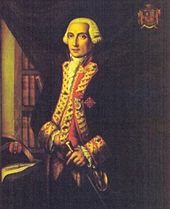 Don Juan de Lángara, c. 1779 portrait by an unknown artist
Don Juan de Lángara, c. 1779 portrait by an unknown artist
Rodney was ill, and would spend the entire action in his bunk. His flag captain, Walter Young, urged Rodney to give orders to engage when the Spanish fleet was first spotted, but Rodney only gave orders to form a line abreast. Lángara started to establish a line of battle, but when he realised the size of Rodney's fleet, he gave orders make all sail for Cadiz. Around 2:00 pm, when Rodney felt certain that the ships seen were not the vanguard of a larger fleet, he issued commands for a general chase.[14] Rodney's instructions to his fleet were to chase at their best speed, and engage the Spanish ships from the rear as they came upon them. They were also instructed to sail to the lee side to interfere with Spanish attempts to gain the safety of a harbour,[15] a tactic that would also prevent the Spanish ships from opening their lowest gun ports.[13] Because of their copper-sheathed hulls (which reduced marine growths and drag), the ships of the Royal Navy were faster and soon gained on the Spanish.[16]
The chase lasted for about two hours, and the battle finally began around 4:00 pm. The Gilbert Blane, the fleet physician, reported it as a decision of the council.[19]
The chase continued into the dark and squally night, leading it to later become known as the "Moonlight Battle", since it was uncommon at the time for naval battles to continue after sunset.[20] At 7:30 pm, HMS Defence came upon Lángara's flagship Fenix, engaging her in a battle lasting over an hour. She was broadsided in passing by HMS Montagu and HMS Prince George, and Lángara was wounded in the battle. Fenix finally surrendered to HMS Bienfaisant, which arrived late in the battle and shot away her mainmast.[18] Fenix's takeover was complicated by an outbreak of smallpox aboard Bienfaisant. Captain John MacBride, rather than sending over a possibly infected prize crew, apprised Lángara of the situation and put him and his crew on parole.[21]
At 9:15 the Montagu engaged the Diligente, which struck after her maintopmast was shot away. Around 11:00 pm San Eugenio surrendered after having all of her masts shot away by HMS Cumberland, but the difficult seas made it impossible to board a prize crew until morning. That duel was passed by HMS Culloden and Prince George, which engaged San Julián and compelled her to surrender around 1:00 am.[18] The last ship to surrender was Monarca. She nearly escaped, shooting away HMS Alcide's topmast, but was engaged in a running battle with the frigate HMS Apollo. Apollo managed to keep up the unequal engagement until about the time that Rodney's flagship Sandwich came upon the scene around 2:00 am. Sandwich fired a broadside, unaware that Monarca had already hauled down her flag.[22]
The British took six ships. Four Spanish ships of the line and the fleet's two frigates escaped, although sources are unclear if two of the Spanish ships were even present with the fleet at the time of the battle. Lángara's report states that San Justo and San Genaro were not in his line of battle (although they are listed in Spanish records as part of his fleet).[23] Rodney's report states that San Justo escaped but was damaged in battle, and that San Genaro escaped without damage.[4] According to one account two of Lángara's ships (unspecified which two) were despatched to investigate other unidentified sails sometime before the action.[2]
Aftermath
With the arrival of daylight, it was clear that the British fleet and their prize ships were dangerously close to a lee shore with an onshore breeze.[22] One of the prizes, San Julián, was recorded by Rodney as too badly damaged to save, and was driven ashore. The fate of another prize, San Eugenio, is unclear. Some sources report that she too was grounded, but others report that she was retaken by her crew and managed to reach Cadiz.[4][15] A Spanish history claims that the prize crews of both ships appealed to their Spanish captors for help escaping the lee shore. The Spanish captains retook control of their ships, imprisoned the British crews, and sailed to Cadiz.[24]
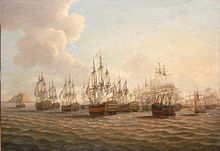 Rodney's Fleet Taking in Prizes After the Moonlight Battle, 16 January 1780, by Dominic Serres (date unknown). The painting shows the British fleet with the captured Spanish squadron in the middle centre.
Rodney's Fleet Taking in Prizes After the Moonlight Battle, 16 January 1780, by Dominic Serres (date unknown). The painting shows the British fleet with the captured Spanish squadron in the middle centre.
The British reported their casualties in the battle as 32 killed and 102 wounded.[3] The supply convoy sailed into Gibraltar on 19 January, driving the smaller blockading fleet to retreat to the safety of Algeciras. Rodney arrived several days later, after first stopping in Tangier. The wounded Spanish prisoners, who included Admiral Lángara, were offloaded there, and the British garrison was heartened by the arrival of the supplies and the presence of Prince William Henry.[22] After also resupplying Minorca, Rodney sailed for the West Indies in February, detaching part of the fleet for service in the Channel. This homebound fleet intercepted a French fleet destined for the East Indies, capturing one warship and three supply ships.[25] Gibraltar would be resupplied twice more before the siege was lifted at the end of the war in 1783.[26]
Admiral Lángara and other Spanish officers were eventually released on parole, the admiral receiving a promotion to lieutenant general.[27] He continued his distinguished career, becoming Spanish marine minister in the French Revolutionary Wars.[28]
Admiral Rodney was lauded for his victory, the first major victory of the war by the Royal Navy over its European opponents. He distinguished himself for the remainder of the war, notably winning the 1782 Battle of the Saintes in which he captured the French Admiral Comte de Grasse. He was, however, criticised by Captain Young, who portrayed him as weak and indecisive in the battle with Lángara.[13][29] (He was also rebuked by the admiralty for leaving a ship of the line at Gibraltar, against his express orders.)[30] Rodney's observations on the benefits of copper sheathing in the victory were influential in British Admiralty decisions to deploy the technology more widely.[25][31]
Order of battle
None of the listed sources give an accurate accounting of the ships in Rodney's fleet at the time of the action. Beatson lists the composition of the fleet at its departure from England, and notes which ships separated to go to the West Indies, as well as those detached to return the prizes captured on 8 January to England.[32] He does not list two ships (Dublin and Shrewsbury, identified in despatches reprinted by Syrett) that were separated from the fleet on 13 January.[11] Furthermore, HMS Prince William is sometimes misunderstood to have been part of the prize escort back to England, but she was present at Gibraltar after the action.[33] Beatson also fails to list a number of frigates, including Second rate
90 Admiral of the White Sir George Rodney (fleet commander)
Walter Young0 0 0 Royal George First rate 100 Rear Admiral of the Blue Robert Digby
John Bourmaster0 0 0 Prince George Second rate 90 Rear Admiral of the Blue Sir John Lockhart-Ross
Philip Patton1 3 4 Ajax Third rate 74 Samuel Uvedale 0 6 6 Alcide Third rate 74 John Brisbane 0 0 0 Bedford Third rate 74 Edmund Affleck 3 9 12 Culloden Third rate 74 George Balfour 0 0 0 Cumberland Third rate 74 Joseph Peyton 0 1 1 Defence Third rate 74 James Cranston 10 12 22 Edgar Third rate 74 John Elliot 6 20 26 Invincible Third rate 74 S. Cornish 3 4 7 Marlborough Third rate 74 Thomas Penny[35] 0 0 0 Monarch Third rate 74 Adam Duncan 3 26 29 Montagu Third rate 74 John Houlton 0 0 0 Resolution Third rate 74 Sir Chaloner Ogle 0 0 0 Terrible Third rate 74 John Leigh Douglas 6 12 18 Bienfaisant Third rate 64 John MacBride 0 0 0 Prince William Third rate 64 Unknown Frigate 32 Philemon Pownoll Frigate 32 Henry Harvey Frigate 28 Skeffington Lutwidge Pegasus Frigate 24 John Bazely Porcupine Frigate 24 Hugh Seymour-Conway Frigate 24 Edward Thompson Unless otherwise cited, table information is from Beatson, pp. 232, 234, and Syrett, p. 274. Full captain names are from Syrett, p. 259.
Blank casualty report fields mean there was no report listed for that ship.There are some discrepancies between the English and Spanish sources listing the Spanish fleet, principally in the number of guns most of the vessels are claimed to mount. The table below lists the Spanish records describing Lángara's fleet. Beatson lists all of the Spanish ships of the line at 70 guns, except Fenix, which he lists at 80 guns. One frigate, the Santa Rosalia, is listed by Beatson at 28 guns.[4] The identify of the second Spanish frigate is different in the two listings. Beatson records her as the Santa Gertrudie, 26 guns, with captain Don Annibal Cassoni, while Duro's listing describes her as Santa Cecilia, 34, captain Don Domingo Grandallana. Both frigates, whatever their identity, escaped the battle.[4][36]
Spanish fleet Ship Rate Guns Commander Notes Fenix Third rate 80 Don Juan de Lángara (fleet commander)
Don Francisco MelgarejoCaptured, 700 men. Princessa Third rate 74 Don Manuel León Captured, 600 men. Diligente Third rate 74 Don Antonio Albornoz Captured, 600 men. Monarca Third rate 74 Don Antonio Oyarvide Captured, 600 men. Santo Domingo Third rate 74 Don Ignacio Mendizábal Blown up. San Agustín Third rate 74 Don Vicente Doz Escaped. San Lorenzo Third rate 74 Don Juan Araoz Escaped with damage. San Julián Third rate 64 Marqués de Medina Captured (600 men), either grounded or retaken. San Eugenio Third rate 74 Don Antonio Damonte Captured (600 men), either grounded or retaken. San Jenaro Third rate 74 Don Félix de Tejada Not listed in Lángara's line of battle. Listed by Beatson as escaping. San Justo Third rate 74 Don Francisco Urreiztieta Not listed in Lángara's line of battle. Listed by Beatson as escaping with damage. Santa Cecilia Frigate 34 Don Domingo Grandallana Identified as Santa Gertrudis in Beatson. Escaped. Santa Rosalia Frigate 34 Don Antonio Ortega Escaped. Unless otherwise cited, table information is from Duro, pp. 259, 263, and Beatson, p. 233. See also
- Battle of Cape St. Vincent (disambiguation), for several other naval battles fought off Cape St Vincent, the best known in 1797
References
- ^ Beatson, p. 232, as modified by Syrett, pp. 241, 306, 311
- ^ a b c Ulloa and Pérez-Mallaína Bueno, p. 33
- ^ a b c Beatson, p. 234
- ^ a b c d e Beatson, p. 233
- ^ Chartrand, pp. 12, 30
- ^ Chartrand, pp. 23, 30–31, 37
- ^ Chartrand, p. 30
- ^ Chartrand, p. 37
- ^ Syrett, pp. 234, 237
- ^ Syrett, pp. 238, 306
- ^ a b Syrett, p. 311
- ^ Chartrand, p. 38
- ^ a b c Syrett, p. 239
- ^ Syrett, pp. 238–239
- ^ a b c Mahan, p. 449
- ^ Willis, p. 34
- ^ Syrett, pp. 240, 313
- ^ a b c Syrett, p. 240
- ^ Mahan, p. 450
- ^ Stewart, p. 131
- ^ "MacBride, John (d. 1800)". Dictionary of National Biography. 1893. p. 428.
- ^ a b c Syrett, p. 241
- ^ Duro, pp. 259, 263
- ^ Lafuente, p. 440
- ^ a b Mahan, p. 451
- ^ Chartrand, p. 31
- ^ Syrett, p. 366
- ^ Harbron, p. 85
- ^ Mahan, p. 535
- ^ Mahan, p. 452
- ^ Syrett, p. 244
- ^ Beatson, pp. 232–233
- ^ See Rodney's despatch (Syrett, p. 305) describing her commissioning, and later references to her in orders at Gibraltar (e.g. Syrett, p. 341).
- ^ Syrett, pp. 241, 274
- ^ Syrett, p. 314
- ^ Duro, p. 263
Sources
- Beatson, Robert (1804). Naval and Military Memoirs of Great Britain, from 1727 to 1783, Volume 6. London: Longman, Hurst, Rees and Orme. OCLC 4643956. http://books.google.com/books?id=btEHAAAAIAAJ&ie=ISO-8859-1&pg=PA233#v=onepage&f=false.
- Chartrand, René (2006). Gibraltar 1779–1783: The Great Siege. Courcelle, Patrice (1st Edition ed.). Oxford: Osprey Publishing. ISBN 9781841769776. OCLC 255272192. http://www.ospreypublishing.com/title_detail.php/title=S9770.
- Duro, Cesáreo Fernández (1901) (in Spanish). Armada Española Desde la Unión de los Reinos de Castilla y de León, Volume 7. Madrid: Establecimiento Tipográfico. OCLC 4413652. http://books.google.com/books?id=G1y3VAtRHTIC&ie=ISO-8859-1&pg=PA259#v=onepage&q&f=false. Reprints Lángara's report.
- Harbron, John (1988). Trafalgar and the Spanish Navy. London: Conway Maritime Press. ISBN 9780851774770. OCLC 19096677.
- Lafuente, Modesto (1858) (in Spanish). Historia General de España, Volume 20. Madrid: Establecimiento Tipográfico de Mellado. OCLC 611596. http://books.google.com/books?id=kBUJAAAAQAAJ&ie=ISO-8859-1&pg=PA440#v=onepage&q&f=false.
- Mahan, Arthur T (1898). Major Operations of the Royal Navy, 1762–1783. Boston: Little, Brown. OCLC 46778589. http://books.google.com/books?id=hpI_AAAAYAAJ&ie=ISO-8859-1&pg=PA449#v=onepage&q=langara&f=false.
- Stewart, William (2009). Admirals of the World: a Biographical Dictionary, 1500 to the Present. Jefferson, NC: McFarland. ISBN 9780786438099. OCLC 426390753.
- Syrett, David (2007). The Rodney Papers: Selections From the Correspondence of Admiral Lord Rodney. Burlington, VT: Ashgate Publishing. ISBN 9780754660071. OCLC 506119281. Reprints numerous British documents concerning Rodney's entire expedition.
- de Ulloa, Antonio; Pérez Mallaína-Bueno, Pablo Emilio (1995) (in Spanish). La campaña de las terceras. Salamanca: Universidad de Sevilla. ISBN 9788447202416.
- Willis, Sam (2008). Fighting at Sea in the Eighteenth Century: the Art of Sailing Warfare. Woodbridge, Suffolk: Boydell Press. ISBN 9781843833673. OCLC 176925283.
Further reading
- de Castro, Adolfo (1858) (in Spanish). Historia de Cádiz y su Provincia. Cádiz: Imprenta de la Revista Médica. OCLC 162549293. http://books.google.com/books?id=yoCPa8wHa50C&ie=ISO-8859-1&pg=PA516#v=onepage&f=false.
- Sapherson, C. A. and Lenton, J. R. (1986) Navy Lists from the Age of Sail; Vol. 2: 1776-1783. Leeds: Raider Games
- Spinney, David (1969) Rodney. London: Allen & Unwin ISBN 0049200224
- Trew, Peter. Rodney and The Breaking of the Line Leo Cooper Ltd (2005) ISBN 9781844151431
Categories:- Conflicts in 1780
- Naval battles involving Spain
- Naval battles involving Great Britain
- Naval battles of the American Revolutionary War
Wikimedia Foundation. 2010.

